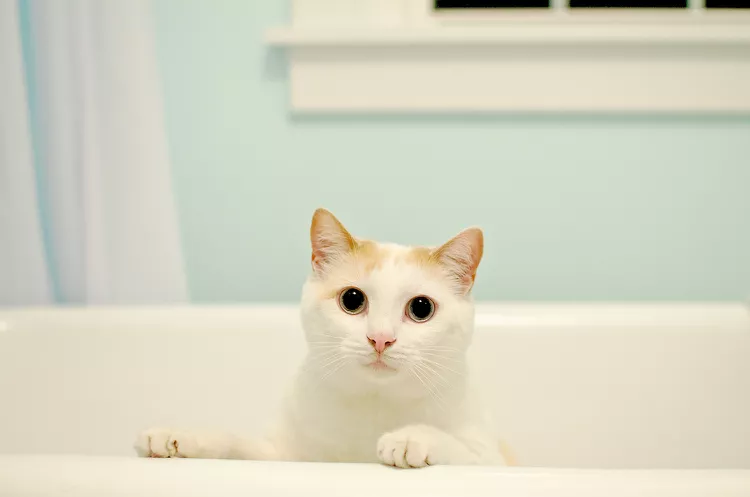How to Bathe Your Kitten or Adult Cat

Kittens learn to lick themselves when they are two to four weeks old and adult cats spend up to 50% of their awake time grooming themselves. So why should you still give your cat a bath? A bath stimulates the skin and removes excess oil, dander, and hair. It also offers an opportunity to teach your cat that being handled even in unexpected ways won't hurt them. Cats will need to be touched by the vet, handled by vet techs, or cared for by house sitters and guests. Making the bath a pleasant experience helps cats "generalize" the event to future similar situations.
Positive experiences with prior baths are especially beneficial if you ever find yourself having to give your cat medicated baths as part of a treatment plan for skin diseases like ringworm or if your cat gets into something particularly nasty.
How Often Should You Bathe Your Cat?
Some fastidious shorthaired cats may rarely if ever need a bath, while cats with longer hair often need a little more help with hygiene. Bathing too often can dry the skin, so try to avoid anything more frequent than every four to six weeks or so. Kittens accept baths most readily so start as soon as you adopt one, as long as it's at least four weeks old. Elderly cats or extremely ill cats are not as adaptable to environmental changes even when temporary. They may be stressed by bathing so follow your veterinarian's recommendation in these instances.
What You Need
For routine cleaning, you only need a few supplies, including:
- A simple grooming shampoo labeled specifically for cats
- Several towels
- A rubber mat
- A washcloth
- Ping pong ball or other floating distraction
It's important to note that human shampoo (including those designed for babies) or dog products can be too harsh and dry the cat's skin, and in some cases may be toxic.
Prepare to Bathe Your Cat
Before getting your cat wet, brush its fur thoroughly. As for you, wear old clothes and expect to get wet.
The bath area should be warm and draft-free. The bathtub will do, but you may be more comfortable if you can bathe your cat in a waist-high sink. Move all breakables out of reach and push drapes or shower curtains out of the way. Avoid anything (strong scents, scary objects, or mirrors) that may potentially frighten your cat so that the bath is as pleasant as possible.
Assemble your shampoo, several towels, and a washcloth near the sink or tub, and run warm water before you bring in the cat. The cat bath temperature should be around body temperature, in other words pretty warm but not so hot that it's uncomfortable.
Place a towel or rubber mat in the bottom of the tub or sink. Cats hate the insecure footing of slippery surfaces and this will make it less stressful. Or, try standing the cat on a plastic milk crate so your cat can grip it with its paws. This also allows you to more easily wash the cat from both above and below.
Close the door to the bathing area, or you risk having a soapy cat escape.
Bathing Kittens
For small cats or kittens, use the double sink in the kitchen, two or more large roasting pans, or a couple of buckets or wastebaskets set in the bathtub. Fill each with warm water, then gently lower your cat (one hand supporting its bottom, the other beneath the chest) into the first container to get it wet. Most cats accept this method more readily than being sprayed.
Let your kitty stand on its hind legs and clutch the edge of the container as you thoroughly wet the fur. Then lift the cat out onto one of your towels, and apply the shampoo, using a damp but not soapy washcloth to clean its face.
After lathering, dip the cat back into the first container to rinse. Get as much soap off as possible before removing and sluice off excess water before thoroughly rinsing in subsequent containers of clean water.
Choose Between the Adult Cat Dip or Spray Method
Jumbo-sized adult cats can be hard to dunk, and running water can be scary for them. Instead, you can use a ladle to dip water. If you have a spray nozzle on the sink, use a low force, with the nozzle close to the fur so the kitty doesn't see the spray.
Never spray in the face; use a damp wash rag to wipe down that area. Keep one hand on the cat at all times to prevent escapes. Rinse beginning at the neck and down the cat's back; don't neglect beneath the tail or on the tummy.
Wrap the clean cat in a dry towel. Shorthaired cats dry quickly, but longhaired felines may need two or more towels to blot away most of the water. If your cat tolerates or enjoys the blow dryer, use only the lowest heat setting and keep the dryer moving to avoid burns.
Preventing Problems With Your Cat During a Bath
Some cats will truly enjoy the bath, and others will not. Remain patient and don't scold your cat during the bath. If your cat is really hating the bath, try plenty of praise, solicit some help, or rinse off the soap and try again next time. If bathing your cat at home seems too problematic, a professional groomer who is experienced with cats is your best bet for effective cleaning by a professional.